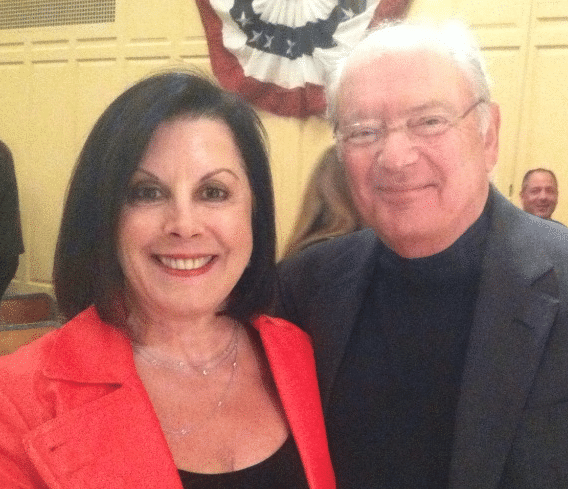by Sylvia DiPietro
When I stepped into a subway car last spring I spotted a colleague. She’s a lawyer like me and was using the ride to fix her makeup. I sat down next to her and teased her about looking pretty. She laughed, stopped primping and surprised me.
“Sylvia, I’m so happy! I left my husband after 28 years. My marriage was dull, dead and other than the fact that my two adult sons are not too thrilled, I’m having the time of my life dating,” she said.
She was so giddy. It was contagious and I wanted whatever she was having. I wanted to be giddy too. Now, I was a very happy gal. I was just a little shy of 65 and still had my looks and good figure. My elder law litigation practice is busy. I fight for victims of elder abuse and try to protect them and their estates. I was also teaching at Brooklyn Law School and served on a number of boards. So my life was busy and I often felt like I was in a pressure cooker.
But there was no man in my life. I was divorced 22 years ago, and divorced a long time before that after a brief marriage in my late teens. My relationship with my wonderful son and two grandsons was fabulous. My friends, both male and female, were all terrific and single as well. My life was happy, rewarding and I can honestly say I experienced no lonely moments, no longing to meet Mr. Right — just wasn’t looking.
But there we were on the subway and my friend asked if I was available to date. She had someone in mind. “Well, why not?” I said.
She set it all up and few days later, I received a call from Joel. He said he was divorced, had two adult children, was 70 years old, retired and was barbequing a fish dinner for himself. It was a long comfortable conversation.
He described his motorcycle riding hobby and told me he was about to leave on a trip to visit the Gettysburg battlefield in Pennsylvania. I had just returned from a trip there with my son’s family. We had things in common and I liked the way he sounded. We agreed to meet in two weeks.
My girlfriends were excited because I was actually going on a date instead of spending my time attending yet another board meeting. One friend insisted that Joel and I meet at One If By Land, Two If By Sea, a romantic restaurant in Greenwich Village.
I was nervous as we got closer to the date. I asked a girlfriend if she thought I might get stood-up. I heard so many horror stories. If it was going to happen to me, I didn’t want to bother to get out of my gym clothes and put on makeup. Of course, no one could tell me what was going to happen.
I tried to calm down and reminded myself that the restaurant was pretty close to my apartment and I could walk home if it turned out to be the date from hell.
When the evening finally arrived, I was ready for anything. We had emailed each other photos to make things easier. But I didn’t spot him. Joel says he saw me right away from his seat at the bar where he was waiting and watching as I talked to the hostess.
After she seated us, all of my impressions of the evening are a blur. It flew by. I remember Joel explaining his background. He told me he was an engineer and described his inventions.
We closed down the restaurant and he drove me the few blocks to my apartment. He kissed me good night in the car and asked if he could take me out again. I figured he would call. But again, all the bad stories about other women’s experiences led me to think he’d call in a couple of weeks or months.
Joel called two days later and we agreed to go Mas, another great Greenwich Village restaurant. He picked me up at my apartment this time. It was a really comfortable old-fashioned date. We enjoyed the meal and the conversation and everything was great. But I shocked myself with a moment of absolute spontaneity. I kissed his bald head when I came back to the table from the ladies’ room. I could not explain or believe my behavior. I was so embarrassed.
After dinner, we walked back to the car and I looked up and said, “The moon is so full it looks like you can pluck it right out of the sky.” Joel smiled, put his arm around me and said, “It’s a kissing moon.” And you know what happened next. We stopped on the corner and just kissed and kissed and kissed.
I don’t remember who had the idea, but we turned the corner and sat down on the steps of 19 King Street and kissed some more. We were there for a couple of hours and suddenly it was 1 a.m. We laughed and kissed and laughed and kissed.
I think we both fell in love almost instantly, although we didn’t say those words.
For the next month, every weekend I traveled to Joel’s home in Bernardsville, New Jersey. But then we had to change this new and satisfying pattern. I was going on an annual trip to visit a girlfriend in Montana. I also planned to take my grandson to Washington, D.C. when I returned. Joel had long-standing plans too. He and his friends were headed to Canada on a motorcycle trip.
We were separated for one long miserable month! We talked every couple of hours, face-timed each other on our iPhones each morning and evening and counted the days. He hinted at marriage before I left and I hinted that he might want to wait a while. But we knew we were right for each other.
I told my son that I was seeing someone but didn’t give him any details. Instead when I was ready, I thought it might be fun if my grandson was the first member of my family to meet Joel. So Joel and I took 13-year-old Charles to visit the USS Intrepid. It was a fun-filled day and Charles began to refer to Joel as my “Joelmate.”
We brought Charles home to his parents and Joel I went to New Jersey and spent a great Labor Day weekend in Bernardsville.
The following week, Joel sent 18 long-stemmed red roses to my apartment. But I was surprised when I got to his home. He had another set of 18 long-stemmed roses waiting for me. At the end of the weekend, as I prepared to return to New York, there was another surprise. He gallantly gave me another bouquet of roses.
My mind was racing. My intuition told me Joel was up to something. Joel smiled, the way he does, and insisted that I read the card. It said, “I love you.” He told me to keep looking in the bouquet. I worked my way down the stems until I found another card that read, “Our love is eternal.” Again, he smiled and said there was more.
“But where?” I asked. “Keeping looking,” he said. And I found a small blue Tiffany pouch with a gorgeous solitaire round diamond. The final card read, “Please say yes!”
I did! Then there was a ping on my iPhone and a text from my grandson asking, “Hey, what’s up? I told him that I had just gotten engaged. He asked for a photo of the ring. Then the texts flew back and forth. It was thrilling and thrilling to share with my family.
Joel is incredibly romantic and I love his enthusiasm about everything. He likes to travel and the great thing is he plans the trips. We went to Antigua in December and now we’re headed to Paris. He’s also taking us back to Antiqua in December 2014. It’s all wonderful.
But Joel is retired and I have no intention of retiring. We’ve blended our lives as much as possible. Joel joined the local political club where I’m active and traveled with me to state and local bar association meetings and political events. We enjoy the arts and attend symphony concerts and visit arts museums in New York and New Jersey.
We also do things separately. Joel rides his motorcycle with friends and keeps up with his college buddies. I’ve got my friends and full schedule.
We plan to marry sometime in January of 2015. Joel wants a big wedding and I would prefer to mosey down to the city clerk’s office. It’s about the only thing so far that we disagree on.
Life is beautiful.
YOU MIGHT ALSO LIKE CHOOSING POWER OF ATTORNEY TIPS BY SYLVIA DIPIETRO
AND  LIVING! AN INSPIRATION
LIVING! AN INSPIRATION
![]() You might also like Figuring Out Medicare Choices
You might also like Figuring Out Medicare Choices


 When we arrived, everyone thought it was a dream house.
When we arrived, everyone thought it was a dream house.  On our last night, the whole gang enjoyed a luau at the Hale Koa Hotel. Both male and female dancers performed traditional Polynesian dances, including the breathtaking fire dance and the graceful, sinuous hula. Lovely maidens crafted flower bracelets for the little girls, and handsome warriors created reed headbands for everyone; a muscular demonstration of how to climb a coconut tree provided yet another highlight of the evening.
On our last night, the whole gang enjoyed a luau at the Hale Koa Hotel. Both male and female dancers performed traditional Polynesian dances, including the breathtaking fire dance and the graceful, sinuous hula. Lovely maidens crafted flower bracelets for the little girls, and handsome warriors created reed headbands for everyone; a muscular demonstration of how to climb a coconut tree provided yet another highlight of the evening. 










 This General Enrollment Period is for people who did not sign up for Part B around the time that you turned 65. You have three months before you turn 65, the month of your 65th birthday and three months after that.
This General Enrollment Period is for people who did not sign up for Part B around the time that you turned 65. You have three months before you turn 65, the month of your 65th birthday and three months after that.









